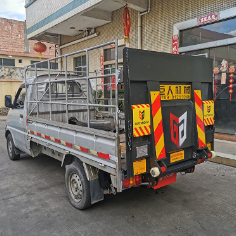
As a convenient equipment for loading and unloading goods, the operation difficulty of the truck tailboard is affected by various factors.
1、 Basic operation process and difficulty
The basic operations of the truck tailboard include raising, lowering, extending, and contracting. For operators familiar with the equipment, starting the lifting function of the tailboard is usually relatively simple, just press the corresponding control button. Under normal circumstances, the tailboard will smoothly rise or fall. However, personnel who are new to the tailboard may need some time to adapt to the force and position of the control buttons to ensure accuracy of operation and avoid accidental movement of the tailboard.
The operation of extending and contracting the tailboard is similar, but the operator needs to pay attention to the direction and degree of extension of the tailboard. If operated improperly, the tailboard may not accurately dock with the loading and unloading platform, or may come into contact with surrounding objects during the stretching process. For example, in narrow loading and unloading spaces, it is necessary to precisely control the angle and length of the tailboard extension, which can be difficult for inexperienced operators.

2、 Difficulty of operation under load influence
When the tail board carries goods, the difficulty of operation will significantly increase. When loading goods, ensure that the tailboard can withstand the weight of the goods and maintain balance. The operator needs to adjust the angle of the tailboard according to the weight distribution of the goods to prevent the goods from slipping due to the tilting of the tailboard. If the goods are heavy and unevenly placed, the tailboard may shake during the lifting process, which not only tests the operator's proficiency in controlling the tailboard, but also requires them to have a certain level of mechanical knowledge and balance.
When unloading goods, attention should also be paid to the smoothness of the operation. Especially when the goods are heavy and unloaded at once, the impact force on the tailboard may affect its stability. The operator needs to operate slowly to avoid severe vibration of the tailboard caused by sudden unloading, which may damage the equipment or affect its next use.
3、 Operational challenges in complex environments
In complex loading and unloading environments, the difficulty of operating the truck tailboard further increases. For example, in adverse weather conditions such as rainy and snowy days, the surface of the tailboard may become slippery, increasing the risk of operators slipping and getting injured, and also affecting the accuracy of tailboard control. Moreover, if the loading and unloading site is uneven, the tail board may experience jamming or uneven stress on the four supporting legs during the lifting process. This requires operators to be keenly aware of these issues and adjust the position of the tailboard or pause operations in a timely manner.
In addition, in environments with obstacles such as other vehicles, piles of goods, or buildings around, operating the tailboard requires greater caution and care. Operators need to accurately calculate the range of motion of the tailboard to avoid collisions with obstacles, which requires a high level of attention and spatial perception ability.
Overall, for experienced personnel, the operation of truck tailboards is not difficult under normal circumstances. However, when factors such as load changes and complex environments are involved, the difficulty of operation will significantly increase, and operators need to undergo specialized training and practice to master it proficiently.

Professional to provide security
for modern logistics
A new company that efficiently handles
and unloads equipment
Please do not hesitate to contact us
0769-81251088

Add friend consultation